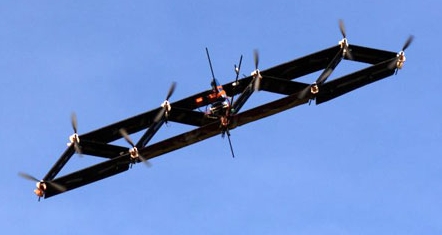
Late happenings at ArduCopter "Factories"...
Another milestone on releases, few weeks ago we had our first official Alpha software release and now saga continues..
It's been long and fast ride in past 6 months. It all started as a dream to create nice expansion for original ArduPilot electronics. Then Jordi and others created new even better and more compact electronics for IMU use, after that people started to create more and more their of flying devices. So finally we decided to take it to next level. Level of ArduCopter and it's full line of electronics, frames and other R/C equipment.
We on development group owe a bit thanks to the whole DIY Drones community and people who are playing key roles on it. Now we already have nice and rather well working ArduCopter software written for the latest hardware and well working fixedwing software so things are looking good on our users perspective. Sure there are still many things to develop, and new development happens every single day, maybe some of our users won't always see it but there are a lot of things done behind the scenes.
In totally on ArduCopter project it self we have around 20 people working with it, some as occasional commiters, some of us are more or less working as full time and some even all day around 7 days per week... Why, well we just like it a lot and we want to provide these good experiences to our users.
I should not need to tell that what we are trying to do here but let's say it anyways. Thing what we try to accomplish with ArduCopter and ArduPilots projects in generally is to create low cost and easy to use UAV platforms that can be extended easily to higher levels. We try to keep designs as simple as possible so people even with low mechanical skills would be comfortable to build them and enjoy of flying.
Naturally our platforms is not for everyone but at least we try to make it suitable for as many as possible. And you can be part of that process. So if you have any ideas just let us know. We are constantly looking new ideas and ways to do things.
ArduCopter KITs
Long waited time has come. We have been using hundreds of people to find all suitable parts and part providers for us, thousands of emails has been sent back and forth and now finally ArduCopter v1.0 release is at hand.
Also long waited prices for KIT's are here too. Our original goal was to create a multirotor platform with less than $1,000.00 USD, and yes Sir, we did it. Actually we did it way under of our first price goals. So here they finally are:
ArduCopter Quad v1.0 Full KIT price will be $499 USD
- ArduPilot Mega
- ArduPilot Mega IMU / OilPan
- MediaTek GPS
- Needed connectors for GPS and APM
- Motors (850kv), ESCs (20Amp), 10x45 Propellers
- Full Frame kit
You only need to add Radio/Receiver and battery to make it complete.
ArduCopter Quad v1.0 Frame KIT, $290 USD
- Full Frame kit
- Motors (850Kv), ESCs (20Amp), 10x45 Propellers
ArduCopter Quad v1.0 Frame itself $160 USD
- Just all frame parts
All frame KIT's have Fixed delivery price of $55 USD and it works most of countries. But due some countries can have high delivery costs, we will cover extras costs as long as they stay under 25%, if it goes more than that we might need to charge small extra for delivery. We are constantly looking better and more economic methods for deliveries.
Hexa and other frames will be available later after basic production is running properly on Quad frames. There also is going to be full range of extra accessories and spareparts for all frames.
Frame itself contains parts like in earlier Beta frame had plus some extras and upgraded parts based on our beta tester comments and proposals. Main changes are in Arches, Power PCB, MotorMount, New choices for arms, landing gear fins, spareparts and also some extra connectors are included on this new frame kit.
Originally we planned to have pre-orders and Asian/European orders under PhiFUN but due legal issues and taxation, we moved it to more official company to ensure that everything is done legally. So we are using Fah Pah Electronics new site that I have been building last week for all our deliveries. All PhiFUN operations has been moved under Fah Pah. (My working table is still on same place and full of tiny AC parts as always hahah).
After normal deliveries has started, ArduCopter KIT's and parts can be found from following shops:
http://store.diydrones.com (for US only)
http://store.jdrones.com (rest of the world)
There will be few local distributors, their names/locations will be announced later (edited to here)
Estimate to start deliveries is now on 1st week of November. Depending on how our Motor and ESC shipment is arriving from factory. We are keeping parts arrival records on our Wiki so check it out.
Now let's fill the world with ArduHappines :)
Cheers,
Jani / The headless ArduCopter man on Youtube ;)

